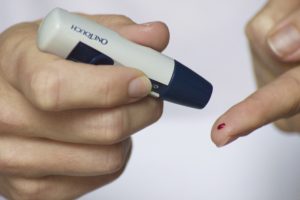Type 1 diabetes has dictated many of the terms of Beth’s life since she was seven years old. Back then, there were not finger stick tests and portable monitors. It was simply regimented meal times and meal plans. And it was all pretty crude.

When she and I began courting, way back in the early 80s, she’d just inherited a little money from her grandma—enough to pay for her first blood glucose monitoring device. It was a breakthrough, but it was high maintenance,
Since then, the monitors have become cheaper, faster, and more compact. Insulin pumps have been a boon to many, and Beth—for nearly the past year—has used something call a CGM (Continuous Glucose Monitor). Here’s how it works: A sensor is applied/installed on Beth’s person via a special applicator. The sensor has a tiny wick that barely penetrates the skin—enough to take readings of blood glucose levels.
We then snap an almond-sized transmitter into the sensor housing. The whole shebang is held on by tape.
Now, in an ankle-bone connected to shin-bone chain, the sensor passes its data to the transmitter, which then transmits the data to an app on Beth’s iPhone. Beth’s iPhone has a feature called Voiceover—Beth then asks Siri, Apple’s personal assistant— “What’s my number?”
And Voila! It tells Beth what her blood sugar is and whether it’s trending down or up. Without pricking her finger.
These things (CGMs) have been around for a good while now. But not talking versions—the iPhone app made it useful for Beth and other visually impaired people with type 1.
At least most of the time. Beth (and I, for that matter–I often help with tests) was used to finger sticking. But it did make for some pretty messed up finger tips. And it’s not great to sneak it out when we’re in public to do a test. In addition, the CGM provides much more or less continuous data, which helps manage insulin levels more granularly.
The kicker: The user can designate other people to follow their readings. So, I can follow Beth’s blood sugar via the internet and an App on my phone.
Until I can’t.
A couple weeks ago, just as Beth and I were leaving to see friends in Washington, D.C., something went haywire. I couldn’t follow the readings. For us, that’s no hardship. I don’t bother checking unless Beth asks me too—mostly when we’re in public spaces when she doesn’t want her phone to bark out her blood sugar numbers.
But then her own readings cut out.
Now, Beth has a talking finger prick monitor that she uses as backup. Except when it doesn’t work. And that’s what we discovered the day before we left for our trip. It fritzed at the worst time.
Yikes. Beth would be flying home after the weekend but I was staying on in D.C. another week for my non-profit organization’s conference.
As it turned out, we learned that the follower outage was a big deal that affected everyone with the same device who had followers. Mostly, this is kids with type 1, and their parents. It even made the NY Times.
We also learned that Beth had experienced a completely unrelated sensor failure.
We were our own little Apollo 13.
And we duct taped our way back to safety. The day before we left for D.C., I ordered a new talking monitor. It arrived the day after Beth got back to Chicago. The intrepid Ms. Finke then asked our building’s generous door person to help her install the batteries, and she was in business, the old-fashioned way (if you can call using a talking, portable blood glucose monitor old fashioned).
When I returned, I helped Beth insert a new sensor, and she and her CGM have been buddies ever since.
Let’s hope it lasts.
Not good. Love your resourcefulness.
Leave a Response